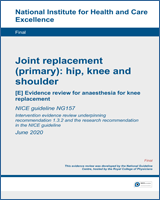From: Evidence review for anaesthesia for knee replacement

NCBI Bookshelf. A service of the National Library of Medicine, National Institutes of Health.
| Outcomes | No of Participants (studies) Follow up | Quality of the evidence (GRADE) | Relative effect (95% CI) | Anticipated absolute effects | |
|---|---|---|---|---|---|
| Risk with Control | Risk difference with Regional with LIA versus regional with nerve block (95% CI) | ||||
| Mortality | Not reported | ||||
| Quality of life | Not reported | ||||
|
Postoperative pain VAS or NRS. Scale from: 0 to 10. |
319 (4 studies) all at some point before the end of postoperative day 1 |
⊕⊕⊝⊝ due to risk of bias, imprecision |
The mean postoperative pain in the control groups was 4 |
The mean postoperative pain in the intervention groups was 0.95 lower (1.5 to 0.39 lower) | |
| Postoperative pain time to onset |
200 (1 study) |
⊕⊕⊕⊝ MODERATE1 due to risk of bias |
The mean postoperative pain in the control groups was 15.3 hours |
The mean postoperative pain in the intervention groups was 6.9 lower (9.34 to 4.46 lower) | |
| Postoperative neurocognitive decline | Not reported | ||||
|
Thromboembolic complications DVT |
70 (1 study) unclear |
⊕⊝⊝⊝ due to risk of bias, imprecision | Peto OR 0.14 (0.0 to 6.82) | 29 per 1000 |
25 fewer per 1000 (from 29 fewer to 166 more) |
| Hospital readmissions For irrigation, debridement and polythene exchange |
40 (1 study) 4 weeks |
⊕⊝⊝⊝ due to risk of bias, imprecision | Peto OR 7.39 (0.15 to 372.38) | 0 per 1000 |
50 more per 1000 (from 80 fewer to 180 more)3 |
|
Postoperative use of analgesia Number of suppositories used |
200 (1 study) 48 hours after surgery |
⊕⊕⊕⊝ MODERATE1 due to risk of bias |
The mean postoperative use of analgesia in the control groups was 2.8 suppositories |
The mean postoperative use of analgesia in the intervention groups was 0.1 higher (0.27 lower to 0.47 higher) | |
|
Postoperative use of analgesia Usage in mg |
389 (5 studies) varying time points no later than postoperative day 3 |
⊕⊝⊝⊝ due to risk of bias, inconsistency, imprecision |
The mean postoperative use of analgesia ranged across control groups from 7-176.5 mg |
The mean postoperative use of analgesia in the intervention groups was 0.29 standard deviations lower (0.61 lower to 0.03 higher) | |
| Length of stay |
214 (4 studies) |
⊕⊕⊕⊝ MODERATE1 due to risk of bias |
The mean length of stay in the control groups was 4.5 days |
The mean length of stay in the intervention groups was 0.29 lower (0.61 lower to 0.03 higher) | |
| Nausea (and vomiting in one paper) |
240 (2 studies) unclear |
⊕⊝⊝⊝ due to risk of bias, imprecision | RR 1.32 (0.59 to 2.94) | 75 per 1000 |
24 more per 1000 (from 31 fewer to 146 more) |
Downgraded by 1 increment if the majority of the evidence was at high risk of bias and downgraded by 2 increments if the majority of the evidence was at very high risk of bias.
Downgraded by 1 increment if the confidence interval crossed 1 MID or by 2 increments if the confidence interval crossed both MIDs.
Absolute effect calculated using the risk difference. RD: 0.05 [−0.08, 0.18]
Downgraded by 1 or 2 increments because the point estimate varies widely across studies, unexplained by subgroup analysis. Random effects model used.
From: Evidence review for anaesthesia for knee replacement

NCBI Bookshelf. A service of the National Library of Medicine, National Institutes of Health.